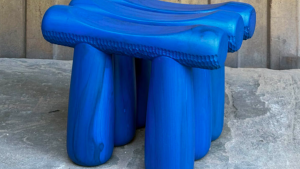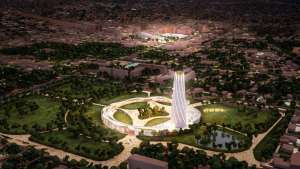A recent architecture graduate, Lehlogonolo Carol Khaas is a multifaceted creative who uses buildings as a medium for storytelling and to create space for freedom and creativity. The young artist and architect, who draws on maps, photography, raw materials and linework to navigate specific spaces, is particularly interested in the physical traces left by previous buildings, and uses these as the key to beginning a project.
Design Indaba spoke to the Emerging Creative about the influence of the Bauhaus art movement in her work, and how art, architecture and design work hand in hand.
Tell us a little bit about your journey with architecture – when did you know that you wanted to study architecture and what does architecture mean to you?
My journey in architecture began in my second-grade design and technology class when I first developed a passion for making things. There was an assignment that required us to build a bridge, and I think from that day on I knew I wanted to make and build things for life. I became acquainted with architecture as an actual profession towards the end of primary school and started to build my life around the idea.
I went to an art-centred high school, which really helped me open up creatively, and then studied architecture at UCT. That was when I really fell in love with architecture as a way of thinking, a form of art and a way of life.
Architecture, to me, is a way of understanding the world, studying our histories and reinterpreting our present lives for the future.
Your designs, like the Edge Museum – your final-year architecture design project – engage heavily with the land. Explain your landcentric approach to architecture.
Land and architecture are synonymous; they’re basically one thing. Arguably, architecture wouldn’t exist if there was no land, so using the resources provided by the land to make sustainable spaces and places is really important.
We’ve been in the midst of a climate crisis for quite a long time, and I think the biggest takeaway so far is that working with the earth is healthier than creating and reproducing materials that go against nature. It is healthier for everything and everyone. I’m a strong believer in using natural materials and materials that will live in harmony with their ecosystems.
Who or what are your most significant influences?
I believe my most significant influence is Walter Gropius’s School of Bauhaus. I really appreciate the idea of using materials in their rawest forms to enhance designs both aesthetically and sustainably.
I also really resonate with some of the basic principles of Bauhaus – form follows function, the smart use of resources and the emphasis on technology – and not just in the literal sense but the idea that every place in the world forms its own technologies. Building technologies, transport technologies and farming technologies all sort of differ from place to place because of the resources we have available.
What are some of your career highlights?
My career as a spatial practitioner and multidisciplinary artist has only just begun – 2021 was my first year out of school. I’m very excited to make a mark or two in these creative industries. I feel being named an Emerging Creative by Design Indaba is a great start!
You’ve also created various collages, line drawings and paintings – how do the disciplines of architecture, art and design intersect for you?
Art, architecture and design work hand in hand, all feeding from and pouring into one another. I love that, for me, architecture and design really speak to the idea that spaces and things can be beautiful, and serve important functions and purposes for the people who use them.
What are you working on at the moment, and what’s next for you?
I have a job as a designer and liaison at one of the top five galleries in Cape Town, SMAC Gallery – I’m really enjoying it and learning a lot from the environment. I am busy with small bodywork, and involved in putting together exhibitions with FEDE Art House, an art collective founded by Lebo Kekana-So be on the lookout.
What’s next for me? I guess we’ll have to see!
Read more:
Credits: Lehlogonolo Carol Khaas







